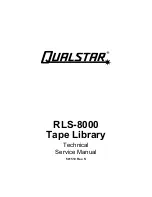
Product Manual - Disc Drive SCSI-2/SCSI-3 Interface (Vol. 2; Ver. 2), Rev. E 177
_____________________________________________________________________________________
5.2.2.6
Verify Command (2Fh)
Table 5.2.2-6. Verify Command
Bit
7
6
5
4
3
2
1
0
Byte(s)
0
0
0
1
0
1
1
1
1
1
Logical Unit No. [1]
DPO
BYT RelAdr
0
0
0
0 [2]
0
0 CHK[3]
[4]
2
Logical Block Address (MSB)
[5]
3
Logical Block Address
[5]
4
Logical Block Address
[5]
5
Logical Block Address (LSB)
[5]
6
0
0
0
0
0
0
0
0
7
Verification Length (MSB)
[6]
8
Verification Length (LSB)
9
0
0
0
0
0
0 Flag Link [7]
The Verify command requests that the target verify the data written on the medium.
This command is implemented with the disc drive specific parameters listed in Table 5.2.2-6.
The drive disconnects while this command is being executed if the initiator supports disconnect/reconnect.
Notes.
[1] LUN must be zero.
[2] A disable page out (DPO) bit of one indicates that the target shall assign the logical blocks accessed by
this command the lowest priority for being fetched into or retained by the cache.
The DPO bit is used to control replacement of logical blocks in the cache memory when the host has
information on the future usage of the logical blocks. If the DPO bit is set to one, the logical blocks
accessed by the command are not likely to be accessed again in the near future and should not be put in
the cache memory nor retained by the cache memory. If the DPO bit is zero, that logical blocks accessed
by this command are likely to be accessed again in the near future.
[3] A Byte Check (BytChk) bit of zero causes the verification to be simply a medium verification (CRC, ECC,
etc). A BytChk bit of one causes a byte by byte compare of data on the medium and the data transferred
from the initiator. If the compare is unsuccessful, the command shall be terminated with a Check Condi-
tion status and the Sense Key shall be set to Miscompare.
[4] RelAdr: See description of RelAdr bit for Write Extended command.
[5] The Logical Block Address specifies the logical block at which the verify operation shall begin, if RelAdr
is Zero.
[6] The Verification Length specifies the number of contiguous logical blocks of data that shall be verified. A
Verification Length of zero indicates that no logical blocks shall be verified (an Implied Seek is still per-
formed). This condition shall not be considered an error. Any other value indicates the number of logical
blocks that shall be verified.
[7] See “Control Byte” paragraph 4.2.6.














































